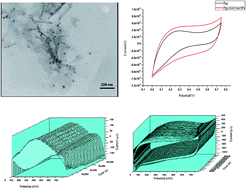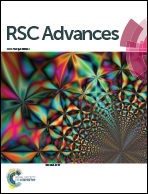Electrochemical study of supercapacitor performance of polypyrrole ternary nanocomposite electrode by fast Fourier transform continuous cyclic voltammetry
Abstract
The supercapacitive behavior of polypyrrole/reduced graphene oxide/Au nano particles (Ppy/rGO/AuNPs) as a ternary composite electrode was studied by cyclic voltammetry (CV), galvanostatic charge/discharge (CD), impedance spectroscopy (EIS) and finally fast Fourier transform continuous cyclic voltammetry (FFTCCV) techniques. A composite electrode was synthesized electrochemically in a 1 M KCl solution containing the pyrrole monomer (0.1 M), rGO/AuNPs (0.2% wt) and 5 mM sodium dodecyl sulfate (SDS). Based on the CV study, the specific capacitances of the Ppy and Ppy/rGO/AuNPs electrodes were calculated to be 190 and 310 F g−1, respectively. CD studies showed that using rGO/AuNPs in the structure of the composite electrode decreases the equivalent series resistance of composite film. FFTCCV is a novel and modern electrochemical technique that presents useful data for studying the performance of active materials. The results showed that after 1200 cycles the Ppy/rGO/AuNPs electrode can retain its capacitance compared with the Ppy electrode.


 Please wait while we load your content...
Please wait while we load your content...